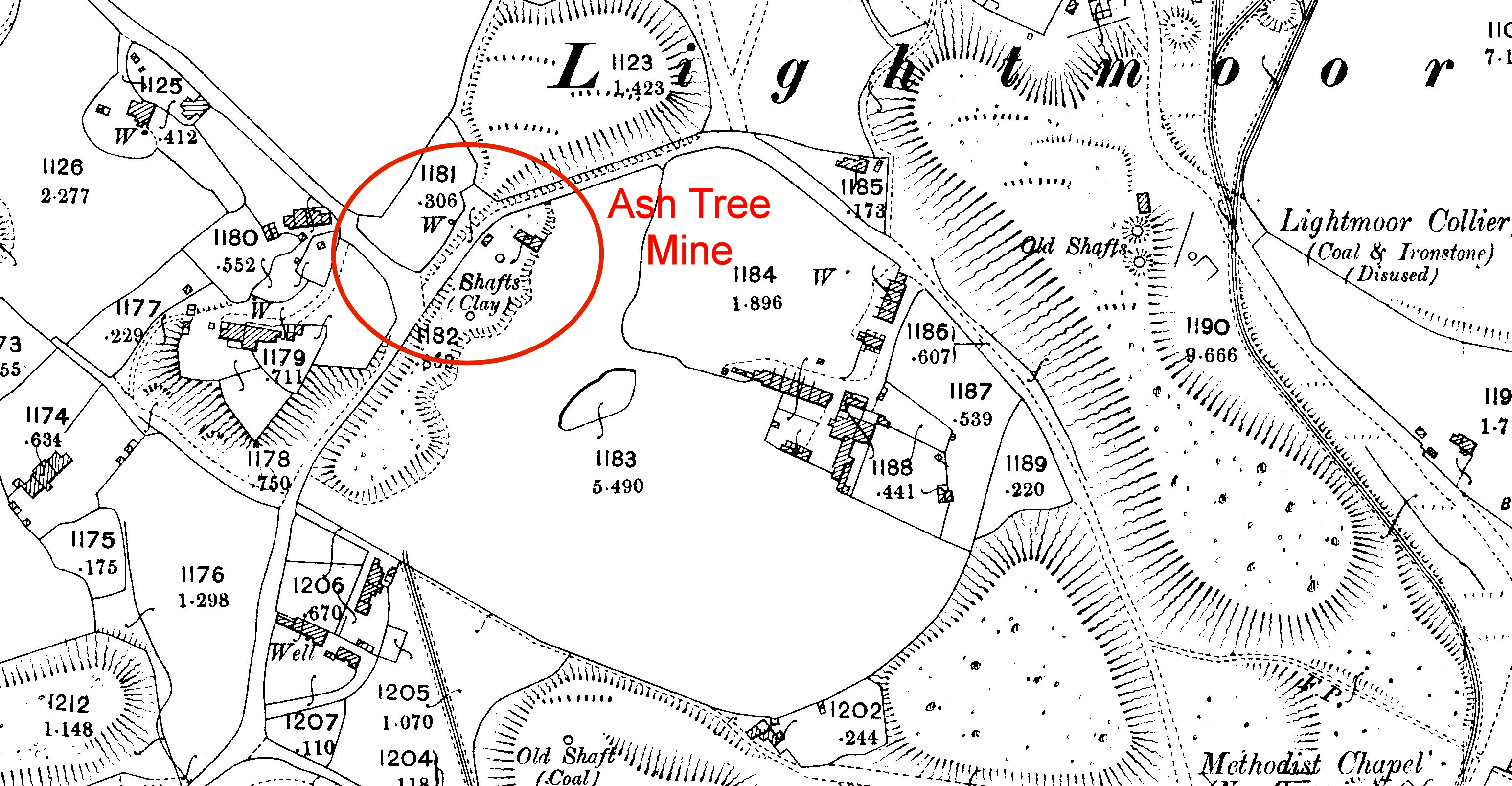Ash Tree Colliery
Owner Coalbrookdale Co. Ltd
Red Clay circa 1894 - 1916
Workers Under Ground 14 | surface 3
Underground manager William Picken

1902 Map
The Ash Tree Colliery was a little west of the Finny at Lightmoor and some of the remains can still be seen today, on the 1902 map it is marked as shafts (Clay) and still working but on the 1925 map it just says Old Shafts, on the 1884 map there is just an empty field, there was a fatal accident at the pit in February 1895 when Henry Jones died from a roof fall (see below), he had worked there for about 12 months, so the pit would have been open in 1894 and closed circa 1920's.
Fatal Accident in a pit.
Wellington Journal - Saturday 23 February 1895
Fatal Accident in a pit. – An inquiry was held by J. V. T. Lander, Esq, coroner, on Thursday, at the house of Mrs. Pearce, into the circumstances under which Henry Jones, 58 years of age, met with his death on the previous Tuesday, while at work in the Ash Tree Pit, Mr. J. Bradburn was foreman of the jury, and Mr. Makepeace, Government Inspector of Mines, was also present, - Elizabeth Jones said deceased was her husband, and they resided at Burroughs Bank. He was a miner, in the employ of the Coalbrookdale Company, and worked at Ash Tree Colliery. Deceased went to work at a few minutes past six on Tuesday morning, and was then in his usual health. He was brought home about three o’clock in the afternoon by a man named Picken and others. They said he had met with a blow, and that his legs were hurt. He was laid on the sofa, and asked witness to take his boots off, which she did. She said, “I will not hurt your legs,” and he replied “It is not my legs; it is my inside.” He said he was going to die. She gave him a drop of tea, but he could hardly swallow it. She asked him what had happened, and he said that a bit of stuff had fallen against him and had caught him on the small of the back. He did not make a complaint against anyone. Sir Charles Soame was sent for, but her husband died before the doctor arrived. Witness saw the body laid out. There was a mark immediately on the small of the back, and a substance on the right side of the hip. – Benjamin Dorsett, Dawley, said he was employed by the Coalbrookdale Company, and worked at Ash Tree Colliery. He was working there with deceased on Tuesday, getting clay. Witness was a loader and deceased was a getter. They started to fill some clay that had fallen from a place where it had been standing for some time. The underground manager, named Picken, went to see them several times during the morning, and about two o’clock he came and worked with deceased for some little time. That would be about three or four yards from where the accident happened. Picken examined the place each time he came, and told Jones not to go further into the old place that he left just before dinner, and he told deceased not to fall any more clay there. After dinner deceased said they would have another draught or two as it would not hurt them. Witness told him it was not safe, but he got nearly enough clay to fill another draught. Whilst he was working some clay fell from the top of the heap. It would be about seven or eight cwt. He shouted to witness, but no sooner had he done so than down the clay came. Witness thought that he meant him to get out of the way, and did not think he was aware the piece above him was falling. Both their lights went out and witness lit his again and called for help. Picken came and found deceased lying on his back, with clay on him – most of it on his legs. They got him out; he did not refer to the fall; he only said he was dying. Witness remained in pit. He heard Picken tell deceased it was not safe to work there. Witness had worked in the clay pit for 12 months, and most of that time with deceased. He considered that deceased was not so careful as he ought to have been, and he had been told not to go into places where it was not safe previous to this. – William Picken, under-manager, corroborated, but said he thought Jones to be a careful and experienced workman, and one whom he could trust to take care of himself. – The jury returned a verdict of “Accidental death.”
Raymond Lewis was a worker at the Ash Tree Pit.
This is from “A Pig On The Wall View Of Dawley” page 99
Raymond Lewis, who worked at the Ash
Tree clay pit near Lightmoor, turning
weathered clay in readiness for tile or
brick-making, led a young men's Bible
Class at the chapel. However, his great
forte was choral music. He was a leading
singer in several local choirs, including
Little Dawley Methodist Church choir. He
later distinguished himself as a highly
skilled conductor of the renowned Hadley
Orpheus Male Voice Choir, coaxing them
to competitive success both in England and
'the lion's den' in Wales. They even won
first prize at the Welsh National
Eisteddford. in the 1920’s.